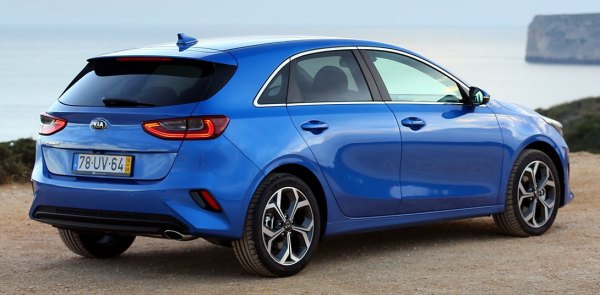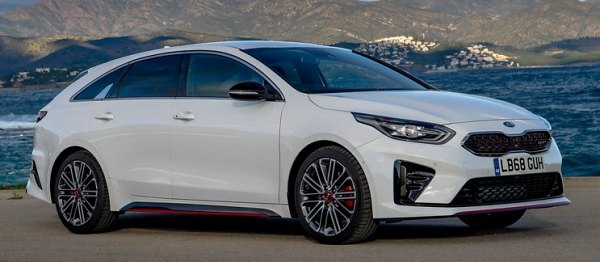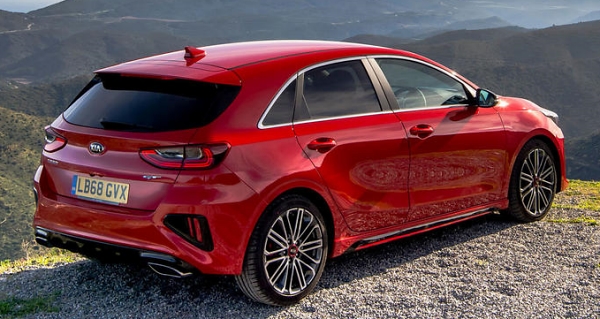Published
on 27
Aug 2018
|
All rights reserved.
|
|
|

|
|
Designed
for Europe and built in Europe for the third time.
|
|
Kia has not just one but
two C-segment family cars. One is K3 / Forte / Cerato, another is
Cee’d. Unlike the former, Ceed is designed specially for Europe and
built in Europe (in Slovakia), where the segment is extremely
competitive. Therefore, Kia has to work its best. The last two
generations Cee’d did achieve a high standard, thanks in part to its
use of multi-link rear suspension whereas most others were still riding
on non-independent twist beam. This paid off in its ride and handling,
which was not up to the level of Ford Focus or VW Golf, but comfortably
above the class norm. In addition to a bargain pricing and all-round
package, the Cee’d established a good reputation in Europe, capturing
1.3 million buyers in 10 years.
The 3rd generation Ceed – note that its name has lost the apostrophe
(') – continues its rise in the rank, albeit at a pace slower than the
second generation. In terms of styling, I am not sure if it is a
progress.
Sure, the fit and finish look better. More subtle curves can be found
all over its body. The “Tiger nose” grille and the new headlamps get
more stylish, too. Somehow, the proportion of the car seems more
conventional and boring, losing the sweeping waistline of the old car.
From the viewpoint of space efficiency and chassis strength, you cannot
argue with the change. From aesthetic point of view, however, it has
lost a bit emotion.

|
|
More
subtle curves but overall this is still a boring design.
|
|
Size-wise, the new car is remarkably close to the old. It keeps the
4310mm length and 2650mm wheelbase unchanged, although 20mm has been
shifted from the front overhang to the rear overhang to boost luggage
space, which is now the second largest in the class at 395 liters.
Meanwhile, 20mm has been added to the width to boost a bit shoulder
room. The roof has been lowered by 23mm to 1447mm, helps lowering
center of gravity and drag. The boot is not only larger, but also
benefited from a wider and deeper tailgate for easier loading.
As before, the Ceed rides on classy multi-link rear suspension. Its new
platform is again shared with Hyundai i30, its European cousin. No
wonder the car’s proportion, dimensions and mechanical specifications
are so close. Predictably, more extensive use of higher strength steel
lightens its monocoque chassis by 23kg while adding strength. More
structural adhesives and sound deadening measures result in vastly
improved refinement. As for suspension tuning, the springs get stiffer
up front and softer at the rear. Anti-roll bars are softened and their
mounting points relocated. Larger, 17-inch wheels and sportier 225/45
tires are fitted on more expensive trims. Is it successful? Well, the
handling is good. The steering is particularly remarkable, being
direct, precise and expertly weighted. It makes the car feels agile.
The car also corners flatly. Grip is plenty. It lacks the front-end
bite and adjustable balance of Ford Focus, but its handling character
is similar to Golf.

|
|
Good handling
is compromised by a harsh ride...
|
|
Nevertheless, the Ceed does not ride as good as Golf. Its suspension
feels stiff. Its ride fidgets over small irregularities. It crashes
over big bumps and bounces over ridges. Only on smooth motorway it will
settle down. More fine tuning to the suspension and tires is required.
Otherwise, the Ceed is refined, because its cabin is well insulated
from noise and the engines are hushed. There are a couple of
world-class direct injection turbo motors, the smaller one has 3
cylinders and displaces 1 liter, producing 120hp. The larger is a
1.4-liter 4-cyilnder with 140hp. Both offer respectable performance,
smoothness and quietness. The 6-speed manual gearbox shifts slickly,
while the optional 7-speed DCT works smoothly, too, although lacking
shift paddles is a waste of material. The powertrain combos are strong.

|
|
Most controls
have substantial feel like a VW product.
|
|
The cabin offers competitive space, which allows a six-footer to sit
comfortably behind another. However, this is no longer the selling
point of the Korean car, as rivals get larger and larger these days.
The Kia’s interior design is about average. Not as inspiring as Peugeot
308 but not as dull as Hyundai i30. The build quality and materials are
satisfying. Most controls have substantial feel like a VW product.
Sure, there are some fake alloy trims, and the electronic tech is
outdated. The infotainment system is not as intuitive to use as VW’s,
and the analogue instrument is conventional. That said, some will
prefer its conventional approach which leaves plenty of hardware
switches.
By most standards, the new Ceed is a good car – solid, well built,
refined powertrains, high practicality and it even steers very well, if
not good enough to threaten Ford Focus or Mazda 3. Unfortunately, its
ride comfort is flawed, and it lacks the inspiration we demand, no
matter in design or innovation. In short, it is competitive rather than
impressive.
|
Verdict:    |
Published
on 25
Jan 2019
|
All rights reserved.
|
|
Proceed and GT
|
|

|
|
What
separates a shooting brake from a wagon? Make it lower, sleeker and
sportier.
|
|
In
the good old days, cars had separate chassis and bodywork.
Coachbuilders got rolling chassis from manufacturers and fitted their
own custom-designed bodywork. This method created countless of great
designs and made the car world far more interesting than today. As
monocoque body became the norm since the 1950s, diversity was
significantly reduced. However, more recently some car makers seem to
have mastered the art to diversify their cars based on the same
underpinnings. The most notable of them is Mercedes-Benz. From the same
MFA platform it created something as diverse as A-class hatchback,
A-class sedan, B-class MPV, CLA-class 4-door coupe, CLA-class shooting
brake and GLA-class SUV, all based on the same underpinnings and much
the same interior bits. Here, we are not talking of just platform
sharing or modular architecture. These cars are so close in the
mechanical side so that their main difference is the bodywork. The art
of coachbuilder has returned, just in the form of mass production.
Hyundai-Kia follows the footprints of Mercedes closely. Take its
European C-segment cars for example, apart from the regular i30 and
Ceed hatchback, each of them is derived into estate/wagon and 5-door
fastback as well, so one set of underpinnings are wrapped with 6
different bodyworks. The 5-door fastback version of Kia is called
Proceed. Unlike the old, awkwardly named Pro_Cee’d, which was a
conventional 3-door warm hatch, the new Proceed is a rakish 5-door
fastback, or what the company calls “shooting brake”. Traditionally, a
shooting brake has to be an estate version of 2-door coupe, like Volvo P1800ES. However,
nowadays car makers call their stylish 5-door wagons also shooting
brake. Then what separates a shooting brake from a wagon? Make it
lower, sleeker and sportier.

|
|
The
whole car is nearly 300mm longer than Ceed, most of which goes to the
rear overhang.
|
|
The new Proceed is exactly that way. Its roof is lowered by 25mm from
the Ceed hatchback. Its windscreen is set at faster angle, ditto the
tailgate. Its side windows get shallower. The whole car is nearly 300mm
(that’s one foot!) longer, most of which goes to the rear overhang,
which enhances the sleeker feel further. As a result, its luggage space
is boosted by half to nearly 600 liters – not quite as large as the
estate version, but nonetheless very useful to take your mountain bike
or surf boards. The sleeker shape makes the Proceed look far more
stylish than the dull-looking Ceed. A shark-fin-shaped chrome at the
C-pillar adds further style.
Inside, there is nothing differing from the usual Ceed, except that the
environment feels less airy and visibility is reduced, especially
rearward. Although the rear seat is already set lower, the swoopy roof
still eats into rear headroom, so those over 6ft tall will not be happy
sitting there. No such problem is found at the driver seat, although it
could be benefited by a lower seating position to match the sportier
pretension. Like Ceed, the interior of Proceed feels solid and build
quality is reasonably high, but not high enough to match VW or Peugeot.
Its dashboard design is quite old-school, although it is easy to use.
The cooking Proceed can be equipped with all engines of the Ceed except
the smallest 3-cylinder. This is understandable, as the car is 25kg
heavier yet needs to promote a sportier image. Top-of-the-range GT
model is powered by the familiar Hyundai group 1.6 GDT engine,
producing 204 horsepower and 195 pound-foot of torque for 140 mph top
speed and 0-60 mph in just over 7 seconds. That is pretty good for a
car classified as "warm hatch". BTW, the Ceed hatchback (pictured
below) also receives the same GT engine.
 |
|
If
you don’t care about the looks or don’t need that large luggage space,
the Ceed GT will be a better choice.
|
|
The Ceed GT is easily faster than a hot hatch of yesteryears, say,
Peugeot 306 GTi-6. However, what makes it a warm rather than hot hatch
is not performance but its driving manner. Hyundai’s 1.6GDT engine is
not known for throttle response or enthusiasm for rev, even in the
world of small turbocharged motors. Moreover, the company’s 7-speed DCT
is slow to upshift, even slower to downshift, and it upshifts
automatically at 6000 rpm. The 6-speed manual is a better bet, but not
world-class either.
The chassis of Proceed GT is better than the powertrain, because it
underwent 6 months of testing under the watch of Albert Biermann.
Compared with Ceed, its suspension is set 5mm closer to the ground,
while springs and anti-roll bars are stiffer as well. Its Michelin PS 4
tires generate excellent grip. Body roll and understeer are well
managed. The steering is quick and weighty enough to inspire
confidence, if still lacking feel. The ride is firm but not
uncomfortable. What it can’t match a good hot hatch is the lack of
adjustable balance. Push harder and it will understeer slightly.
Lifting off does not trigger oversteer. However, being a 5-door
shooting brake, this is understandable.
If you don’t care about the looks or don’t need that large luggage
space, the Ceed GT will be a better choice. It is lighter and shorter,
thus feels a tad faster and more agile. Moreover, it is considerably
cheaper as well. The Proceed GT is not bad, far from it actually, but
it seems to be too expensive for a Kia warm hatch. The Korean might
have ambition to rise to premium status, but a car like Proceed is
probably too early. At least you won't confuse it with a Mercedes CLA
shooting brake.
|
Verdict:    |
|